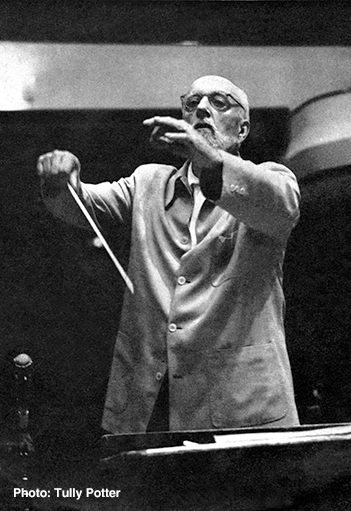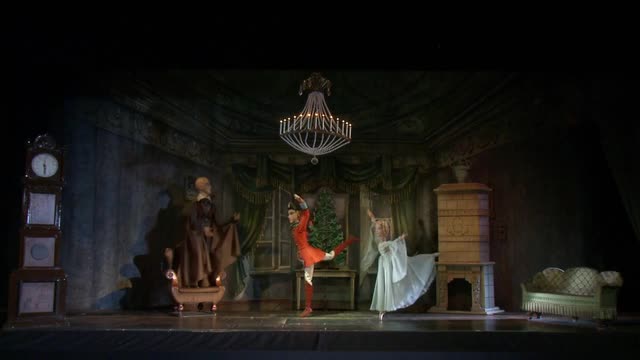

Ernest Ansermet’s parents were both amateur musicians, and his father was a mathematician. While very young Ernest was strongly attracted to music, and studied the violin, clarinet, and several other wind instruments. However, although he was passionate about music, he was equally attracted to mathematics, which he studied at the Sorbonne in Paris and at the University of Lausanne, from which he graduated in 1903. He continued his mathematical studies in Paris as these allowed him also to attend the Paris Conservatoire. Returning to Lausanne as professor of mathematics between 1905 and 1909, he also during this period studied composition with Ernest Bloch. Between 1909 and 1910 he was in Berlin where he came into contact with the eminent conductors Nikisch, Weingartner and Mottl.
In 1910, Ansermet conducted his first concerts in Lausanne and Montreux, becoming in 1911 the conductor of the concerts at the Kursaal de Montreux in succession to Francisco de Lacerda, who had been a significant influence. Between 1913 and 1915, he conducted in Geneva, and was appointed conductor of the Geneva Symphony Orchestra in 1915. During this period, through his friendship with C.F. Ramuz, he came into contact with Igor Stravinsky, who was living at Clarens, and assisted him with the composition of several of his works. In 1915, Stravinsky recommended Ansermet to Diaghilev to be the conductor of the Ballets Russes, and he was duly appointed. In addition, from 1915, he created and conducted a national orchestra in Argentina based in Buenos Aires; for the next ten years he would spend the winter in Geneva and the summer in Argentina.
Henceforth Ansermet was to pursue a multiple career, conducting in Geneva, Buenos Aires and on tour with the Ballets Russes. In 1916, he conducted this company on its tour of the United States, making his first recordings with its orchestra. He conducted the first performances of many notable works commissioned by Diaghilev, including Stravinsky’s The Soldier’s Tale (1918), Pulcinella (1920), Renard (1922) and Les Noces (1923), as well as Satie’s Parade (1917), Falla’s El sombrero de tres picos (1919) and Prokofiev’s Chout (1923). A further significant step was taken in 1918 when Ansermet formed in Geneva the Suisse Romande Orchestra, which he was to conduct continuously until 1968. This was Geneva’s first permanent orchestra, with a strength of 63 musicians, many of whom initially were from other countries; but by 1946 60% were Swiss.
Between the two world wars Ansermet toured extensively, making guest appearances throughout Europe, the United States and South America, and in the process acquiring a distinguished reputation. In 1935, Swiss Radio formed an orchestra in Lausanne and Ansermet worked hard to stabilise the position of his own orchestra. Eventually, by 1940, its future was assured, with an annual schedule of concerts in Geneva and Lausanne, pit work in the Grand Theatre of Geneva, and broadcast concerts for the Suisse Romande Radio. Its size increased to 84 players, and Ansermet sought to differentiate it from the other two major Swiss orchestras in Zürich and Winterthur by presenting a wide repertoire.
In 1946, Ansermet signed an exclusive contract with Decca, and began to make records that used Decca’s ‘Full Frequency Range Recording’ system. These set new standards for high fidelity and through their international success, Ansermet’s fame continued to grow until his death in 1969. Initially he recorded with the London Symphony, London Philharmonic and Paris Conservatoire Orchestras, but the majority of his later recordings were made with his own orchestra in Geneva, which he believed best realised his personal musical style and interpretations.
As a conductor Ansermet had a precise and emphatic technique. He firmly believed that an orchestra’s style was formed by its permanent conductor and that guest conductors hardly changed this. He also felt that the conductor’s function was to illustrate the composer’s style as he (the conductor) felt it to be, and that the written indications were only relative. Performance required more than just the observance of the score. In 1948, he was quoted in America as saying, ‘Making music cannot be reduced to performing what is written, because music is not an acoustic phenomenon: it is something which is inside the acoustic phenomenon and its truth cannot be formulated’. Since each musician had his own view of this truth, it was quite feasible to have different but equally satisfactory performances of the same piece of music.
Through his close association with Decca and its head of classical music, Maurice Rosengarten, who was also based in Switzerland, Ansermet’s catalogue of recordings grew progressively larger. Initially it reflected his sympathy for music by then-contemporary composers, such as Stravinsky, Prokofiev, Ravel, Debussy, Roussel, Honegger and Frank Martin, as well as the brilliant orchestral writing of the nineteenth-century Russian composers. As this repertoire gradually became exhausted Ansermet moved into more mainstream territory, conducting symphonies by Beethoven, Schumann, Mendelssohn, Brahms, and Sibelius, as well as miscellaneous works by Weber, Berlioz and Wagner. Sound as these later recordings were, it is through his performances of the Russian and French repertoire that he is most likely to continue to command respect and admiration.
© Naxos Rights International Ltd. — David Patmore (A–Z of Conductors, Naxos 8.558087–90).
| Title | |
| TCHAIKOVSKY, P.I.: Nutcracker (The) [Ballet] (Salzburg Marionette Theatre, 2014) | |

|
TCHAIKOVSKY, P.I.: Nutcracker (The) [Ballet] (Salzburg Marionette Theatre, 2014)
Composer:
Tchaikovsky, Pyotr Il'yich
Artists:
Aicher, Gretl -- Ansermet, Ernest -- Brunner, Philippe -- Droin, Pierre -- Engl, Andrea -- Fediakov, Vladimir -- Grill, Elfriede -- Holzl, Heide -- Obermayr, Michaela -- Salzburg Marionette Theatre -- Swiss Romande Orchestra -- Tikhonov, Pavel -- Wiener, Eva -- Winzer, Ursula
Label/Producer: Belvedere edition |
